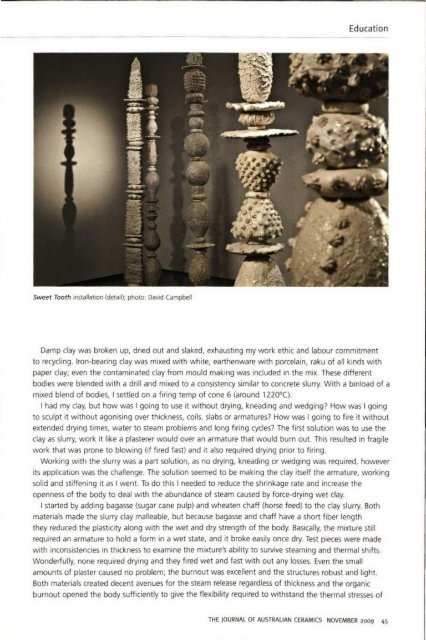The Journal of Australian Ceramics Vol 48 No 3 November 2009
Create successful ePaper yourself
Turn your PDF publications into a flip-book with our unique Google optimized e-Paper software.
Education<br />
Sweet Tooth installation (detail); photo: David Campbell<br />
Damp clay was broken up, dried out and slaked, exhausting my work ethic and labour commitment<br />
to recycling. Iron-bearing clay was mixed with white, earthenware with porcelain, raku <strong>of</strong> all kinds with<br />
paper clay; even the contaminated clay from mould making was included in the mix. <strong>The</strong>se different<br />
bodies were blended with a drill and mixed to a consistency similar to concrete slurry. With a binload <strong>of</strong> a<br />
mixed blend <strong>of</strong> bodies, I settled on a firing temp <strong>of</strong> cone 6 (around 1220°C).<br />
I had my clay, but how was I going to use it without drying, kneading and wedging? How was I going<br />
to sculpt it without agonising over thickness, coils, slabs or armatures) How was I going to fire it without<br />
extended drying times, water to steam problems and long firing cycles? <strong>The</strong> first solution was to use the<br />
clay as slurry, work it like a plasterer would over an armature that would burn out. This resulted in fragile<br />
work that was prone to blowing (if fired fast) and it also required drying prior to firing.<br />
Working with the slurry was a part solution, as no drying, kneading or wedging was required, however<br />
its application was the challenge. <strong>The</strong> solution seemed to be making the clay itself the armature, working<br />
solid and stiffening it as I went. To do this I needed to reduce the shrinkage rate and increase the<br />
openness <strong>of</strong> the body to deal with the abundance <strong>of</strong> steam caused by force-drying wet clay.<br />
I started by adding bagasse (sugar cane pulp) and wheaten chaff (horse feed) to the clay slurry. Both<br />
materials made the slurry clay malleable, but because bagasse and chaff have a short fiber length<br />
they reduced the plasticity along with the wet and dry strength <strong>of</strong> the body. Basically, the mixture still<br />
required an armature to hold a form in a wet state, and it broke easily once dry. Test pieces were made<br />
with inconsistencies in thickness to examine the mixture's ability to survive steaming and thermal shifts.<br />
Wonderfully, none required drying and they fired wet and fast with out any losses. Even the small<br />
amounts <strong>of</strong> plaster caused no problem; the burnout was excellent and the structures robust and light.<br />
Both materials created decent avenues for the steam release regardless <strong>of</strong> thickness and the organic<br />
burnout opened the body sufficiently to give the flexibility required to withstand the thermal stresses <strong>of</strong><br />
THE JOURNAL OF AUSTRALIAN CERAMI CS NOVEMBER <strong>2009</strong> 45


















